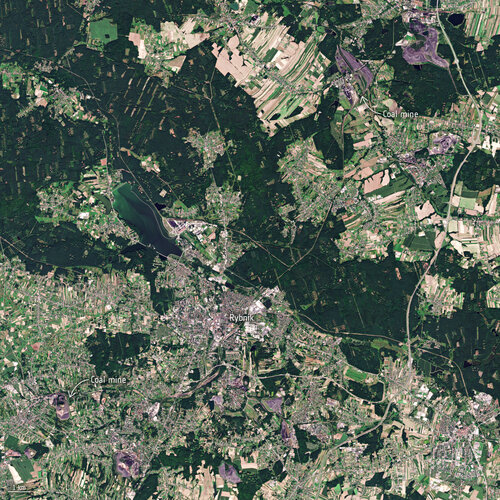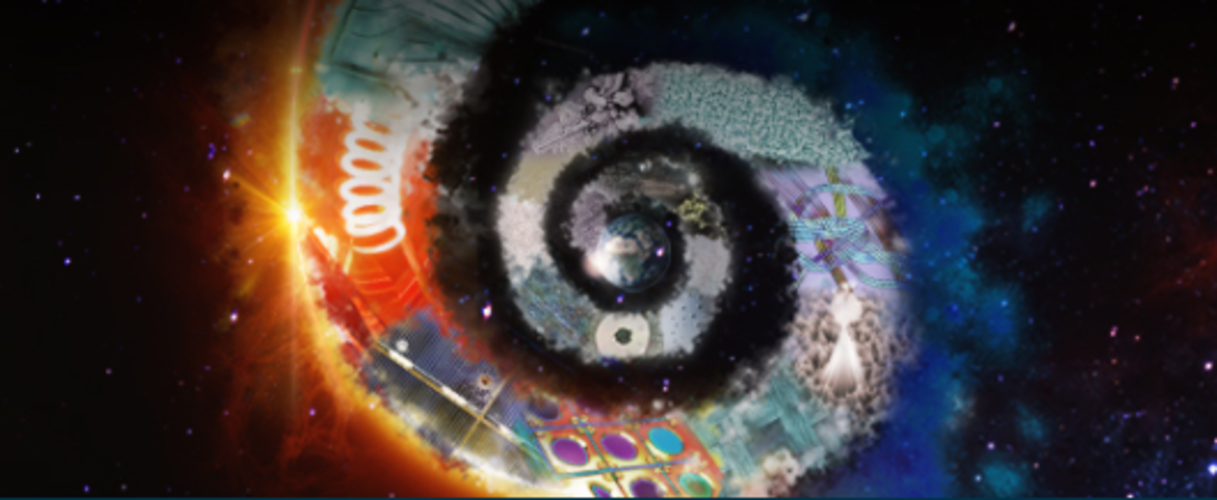
Copernical Team
Monday, 21 March 2022 10:30
Methane detected over Poland’s coal mines

Data from the Tropomi instrument onboard the Copernicus Sentinel-5P satellite has been used to detect methane plumes over some of Europe’s largest methane-emitting coal mines.
Published in
News
Tagged under
Monday, 21 March 2022 07:05
Surviving space: major conference focuses on materials in space environment

Materials make the space mission – but ensuring they survive in space is always a challenge. The very act of transporting them beyond Earth ensures their characteristics will alter as they interact with the space environment in complex ways.
Published in
News
Tagged under
Sunday, 20 March 2022 10:04
SpaceX launches 53 Starlink satellites after weather delays
Washington DC (UPI) Mar 19, 2021
 Elon Musk's SpaceX launched 53 Starlink satellites from Florida early Saturday morning after the launch was postponed Friday night because of stormy weather.
The launch, which came days after the company celebrated its 20th anniversary, was pushed back to 12:42 a.m. EDT when stormy weather near Complex 40 at Cape Canaveral Space Force Station had cleared.
The spacecraft was initi
Elon Musk's SpaceX launched 53 Starlink satellites from Florida early Saturday morning after the launch was postponed Friday night because of stormy weather.
The launch, which came days after the company celebrated its 20th anniversary, was pushed back to 12:42 a.m. EDT when stormy weather near Complex 40 at Cape Canaveral Space Force Station had cleared.
The spacecraft was initi
 Elon Musk's SpaceX launched 53 Starlink satellites from Florida early Saturday morning after the launch was postponed Friday night because of stormy weather.
The launch, which came days after the company celebrated its 20th anniversary, was pushed back to 12:42 a.m. EDT when stormy weather near Complex 40 at Cape Canaveral Space Force Station had cleared.
The spacecraft was initi
Elon Musk's SpaceX launched 53 Starlink satellites from Florida early Saturday morning after the launch was postponed Friday night because of stormy weather.
The launch, which came days after the company celebrated its 20th anniversary, was pushed back to 12:42 a.m. EDT when stormy weather near Complex 40 at Cape Canaveral Space Force Station had cleared.
The spacecraft was initi
Published in
News
Tagged under
Friday, 18 March 2022 20:26
3 cosmonauts arrive at space station in yellow and blue

A trio of Russian cosmonauts arrived at the International Space Station on Friday, the first new faces in space since the start of the Russian war in Ukraine.
Published in
News
Tagged under
Saturday, 19 March 2022 11:04
Northrop Grumman's Space Tracking and Surveillance System completes mission
Redondo Beach CA (SPX) Mar 18, 2022
 Built by Northrop Grumman in support of the Missile Defense Agency, two demonstration Space Tracking and Surveillance System (STSS) satellites successfully completed their missions and have been retired. Their achievements pave the way for future operational missile warning and tracking systems that will defend the nation.
"Launched in 2009 and expected to operate for four years, these dem
Built by Northrop Grumman in support of the Missile Defense Agency, two demonstration Space Tracking and Surveillance System (STSS) satellites successfully completed their missions and have been retired. Their achievements pave the way for future operational missile warning and tracking systems that will defend the nation.
"Launched in 2009 and expected to operate for four years, these dem
Published in
News
Tagged under
Saturday, 19 March 2022 11:04
China's space station to support large-scale scientific research
Beijing (XNA) Mar 19, 2022
 China plans to conduct a number of frontier scientific experiments on its Tiangong space station, with the two laboratory modules, Wentian and Mengtian, scheduled to be launched this year, according to the Technology and Engineering Center for Space Utilization under the Chinese Academy of Sciences.
The experiments include raising fish, growing vegetables, setting up the most precise clock
China plans to conduct a number of frontier scientific experiments on its Tiangong space station, with the two laboratory modules, Wentian and Mengtian, scheduled to be launched this year, according to the Technology and Engineering Center for Space Utilization under the Chinese Academy of Sciences.
The experiments include raising fish, growing vegetables, setting up the most precise clock
 China plans to conduct a number of frontier scientific experiments on its Tiangong space station, with the two laboratory modules, Wentian and Mengtian, scheduled to be launched this year, according to the Technology and Engineering Center for Space Utilization under the Chinese Academy of Sciences.
The experiments include raising fish, growing vegetables, setting up the most precise clock
China plans to conduct a number of frontier scientific experiments on its Tiangong space station, with the two laboratory modules, Wentian and Mengtian, scheduled to be launched this year, according to the Technology and Engineering Center for Space Utilization under the Chinese Academy of Sciences.
The experiments include raising fish, growing vegetables, setting up the most precise clock
Published in
News
Tagged under
Saturday, 19 March 2022 11:04
Russia's energy clout also comes from being a key nuclear supplier
Golden CO (SPX) Mar 19, 2022
 As Western nations look for ways to reduce their reliance on Russian oil and gas, another aspect of the Ukraine crisis has received less attention: Most of the 32 countries that use nuclear power rely on Russia for some part of their nuclear fuel supply chain.
Nuclear power is a critical part of many national electricity grids. European countries especially rely on nuclear power, including
As Western nations look for ways to reduce their reliance on Russian oil and gas, another aspect of the Ukraine crisis has received less attention: Most of the 32 countries that use nuclear power rely on Russia for some part of their nuclear fuel supply chain.
Nuclear power is a critical part of many national electricity grids. European countries especially rely on nuclear power, including
 As Western nations look for ways to reduce their reliance on Russian oil and gas, another aspect of the Ukraine crisis has received less attention: Most of the 32 countries that use nuclear power rely on Russia for some part of their nuclear fuel supply chain.
Nuclear power is a critical part of many national electricity grids. European countries especially rely on nuclear power, including
As Western nations look for ways to reduce their reliance on Russian oil and gas, another aspect of the Ukraine crisis has received less attention: Most of the 32 countries that use nuclear power rely on Russia for some part of their nuclear fuel supply chain.
Nuclear power is a critical part of many national electricity grids. European countries especially rely on nuclear power, including
Published in
News
Tagged under
Saturday, 19 March 2022 11:04
Government of Canada invests in small modular reactor technology
Burlington, Canada (SPX) Mar 18, 2022
 Canada is a leader in nuclear energy and nuclear safety and has one of the world's most promising domestic markets for the safe and responsible development of small modular reactor (SMR) technology. SMRs have the potential to provide strong economic benefits to the Canadian economy and support Canada's efforts to achieve net-zero greenhouse gas emissions by 2050.
The Honourable Francois-Ph
Canada is a leader in nuclear energy and nuclear safety and has one of the world's most promising domestic markets for the safe and responsible development of small modular reactor (SMR) technology. SMRs have the potential to provide strong economic benefits to the Canadian economy and support Canada's efforts to achieve net-zero greenhouse gas emissions by 2050.
The Honourable Francois-Ph
 Canada is a leader in nuclear energy and nuclear safety and has one of the world's most promising domestic markets for the safe and responsible development of small modular reactor (SMR) technology. SMRs have the potential to provide strong economic benefits to the Canadian economy and support Canada's efforts to achieve net-zero greenhouse gas emissions by 2050.
The Honourable Francois-Ph
Canada is a leader in nuclear energy and nuclear safety and has one of the world's most promising domestic markets for the safe and responsible development of small modular reactor (SMR) technology. SMRs have the potential to provide strong economic benefits to the Canadian economy and support Canada's efforts to achieve net-zero greenhouse gas emissions by 2050.
The Honourable Francois-Ph
Published in
News
Tagged under
Saturday, 19 March 2022 11:04
NASA spots giant debris cloud created by clashing celestial bodies
Pasadena CA (JPL) Mar 19, 2022
 Major smashups between rocky bodies shaped our solar system. Observations of a similar crash give clues about how frequent these events are around other stars. Most of the rocky planets and satellites in our solar system, including Earth and the Moon, were formed or shaped by massive collisions early in the solar system's history. By smashing together, rocky bodies can accumulate more material,
Major smashups between rocky bodies shaped our solar system. Observations of a similar crash give clues about how frequent these events are around other stars. Most of the rocky planets and satellites in our solar system, including Earth and the Moon, were formed or shaped by massive collisions early in the solar system's history. By smashing together, rocky bodies can accumulate more material,
 Major smashups between rocky bodies shaped our solar system. Observations of a similar crash give clues about how frequent these events are around other stars. Most of the rocky planets and satellites in our solar system, including Earth and the Moon, were formed or shaped by massive collisions early in the solar system's history. By smashing together, rocky bodies can accumulate more material,
Major smashups between rocky bodies shaped our solar system. Observations of a similar crash give clues about how frequent these events are around other stars. Most of the rocky planets and satellites in our solar system, including Earth and the Moon, were formed or shaped by massive collisions early in the solar system's history. By smashing together, rocky bodies can accumulate more material,
Published in
News
Tagged under
Saturday, 19 March 2022 11:04
Black swifts descended rapidly during lunar eclipse
Washington DC (SPX) Mar 18, 2022
 An international research team led by Lund University in Sweden has managed to study the flight behaviour of the mysterious black swift. They found, among other things, that the black swift rises to extreme heights during a full moon, seemingly catching insects in the moonlight. And, during a lunar eclipse, the birds simultaneously lost altitude. The results are published in Current Biology.
An international research team led by Lund University in Sweden has managed to study the flight behaviour of the mysterious black swift. They found, among other things, that the black swift rises to extreme heights during a full moon, seemingly catching insects in the moonlight. And, during a lunar eclipse, the birds simultaneously lost altitude. The results are published in Current Biology.
 An international research team led by Lund University in Sweden has managed to study the flight behaviour of the mysterious black swift. They found, among other things, that the black swift rises to extreme heights during a full moon, seemingly catching insects in the moonlight. And, during a lunar eclipse, the birds simultaneously lost altitude. The results are published in Current Biology.
An international research team led by Lund University in Sweden has managed to study the flight behaviour of the mysterious black swift. They found, among other things, that the black swift rises to extreme heights during a full moon, seemingly catching insects in the moonlight. And, during a lunar eclipse, the birds simultaneously lost altitude. The results are published in Current Biology.
Published in
News
Tagged under
